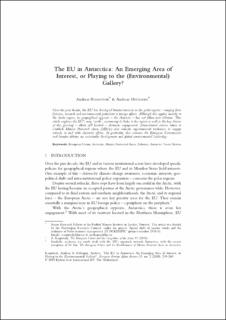| dc.contributor.author | Raspotnik, Andreas | |
| dc.contributor.author | Østhagen, Andreas | |
| dc.date.accessioned | 2020-08-24T10:49:28Z | |
| dc.date.available | 2020-08-24T10:49:28Z | |
| dc.date.created | 2020-07-15T15:33:12Z | |
| dc.date.issued | 2020 | |
| dc.identifier.citation | European Foreign Affairs Review. 2020, 25 (2), 239-260. | en_US |
| dc.identifier.issn | 1384-6299 | |
| dc.identifier.uri | https://hdl.handle.net/11250/2673594 | |
| dc.description.abstract | Over the past decade, the EU has developed broader interests in the polar regions – ranging from fisheries, research and environmental protection to foreign affairs. Although this applies mainly to the Arctic region, its geographical opposite – the Antarctic – has not fallen into oblivion. This article explores the EU’s way ‘south’, examining its links to the region as well as the key drivers of this growing – albeit still limited – Antarctic engagement. International actions taken to establish Marine Protected Areas (MPAs) also indicate supranational tendencies to engage actively in and with Antarctic affairs. In particular, this concerns the European Commission and broader debates on sustainable development and global environmental leadership. | |
| dc.language.iso | eng | en_US |
| dc.title | The EU in Antarctica: An Emerging Area of Interest, or Playing to the (Environmental) Gallery? | en_US |
| dc.type | Peer reviewed | en_US |
| dc.type | Journal article | en_US |
| dc.description.version | publishedVersion | |
| dc.source.pagenumber | 239-260 | en_US |
| dc.source.volume | 25 | en_US |
| dc.source.journal | European Foreign Affairs Review | en_US |
| dc.source.issue | 2 | en_US |
| dc.identifier.cristin | 1819514 | |
| dc.relation.project | Norges forskningsråd: 257614 | en_US |
| dc.relation.project | Fridtjof Nansens institutt: 393 | en_US |
| cristin.ispublished | true | |
| cristin.fulltext | original | |
| cristin.qualitycode | 1 | |
